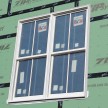Understanding Condensation in Your Home
Window Condensation
What do houseplants, a boiling pot of pasta and your shower all have in common? They all add moisture to your home’s interior. And, while some humidity in the home is good, excessive moisture can be uncomfortable.
“We often get calls from homeowners who are concerned that their windows are ‘sweating’ or leaking either inside or outside the home because they see moisture on the glass,” says Christopher Burk, technical product manager at Simonton Windows®. “In reality, that’s simply not the case. While condensation may collect on the interior or exterior of energy-efficient windows, the units are really doing their job by helping serve as a barrier in the home.”
Burk points out that windows do not cause condensation — they simply prevent the moisture in the home from escaping to the outside. “If the inside glass surface on double- or triple-glazed windows show excessive moisture, you can be reasonably sure that the moisture is also collecting on your walls and ceilings,” says Burk. “This means you should take steps to reduce the humidity level in your home by using exhaust fans and dehumidifiers.”
Where Does Condensation Come From
You’d be surprised how much water vapor homeowners create themselves on a daily basis. A family of four can add a half pint of water vapor every hour to the home just through normal breathing and perspiration. And, if you take a five-minute shower, you produce another half pint of water vapor. Even the simple act of cooking dinner on a gas stove can produce two and a half pints of water vapor.*
“Invisible water vapor is everywhere in the home,” says Burk. “The key is for homeowners to monitor the levels of moisture in their homes and then take steps to manage the humidity levels.”
What Can a Homeowner Do to Help Reduce Condensation?
Water vapor is part of our lives and our homes. To help control the amount of condensation in the home, experts at Simonton Windows recommend the following tips:
- Use kitchen and bathroom exhaust fans.
- If you have a humidifier, set it to the correct outside temperature.
- If your home is overly humid, or if you have a damp basement, use a dehumidifier.
- Properly vent clothes dryers, gas appliances and stoves.
- Open a window in the bathroom.
- Make sure your attic, basement and crawl spaces are well ventilated and free from obstructions.
- Store firewood outside.
- Freshly-cut wood can consist of up to 45 percent water, which adds water vapor to the home. Even well-seasoned firewood generally has a 20 to 25 percent moisture content.**
- Open curtains and blinds to allow more air circulation around your windows
Worrisome Windows
Homeowners with the most cause for concern are those with older, less efficient windows. “Windows are just like any other major part of the home,” says Burk. “They wear out over time and need to be replaced. If your windows have air leaks, don’t close properly, or are failing to act as a solid barrier to the environment, then it’s time to consider replacing them with energy-efficient windows.”
Burk also recommends knowing the difference between condensation on the glass and between the glass panes of the window. “If you are seeing moisture, fogging or cloudiness between the panes of glass in your window, this is a strong indication that the seal of your window has failed and it’s time to get a new window,” says Burk. “Failed seals lack the energy efficiency and features necessary to help you keep energy bills low and enjoy comfortable living in your home. While condensation on the interior or exterior of the glass is manageable, moisture between the glass needs swift attention by homeowners.”
*Source: Moisture Sources Associated with Potential Damage in Cold Climate Housing (1988)
**Source: http//www.csia.org/HomeownerResources/ChimneySafetyInfo/HowtoSelectFirewood/tabid/115/Default.aspx








